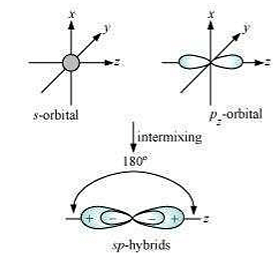What is meant by hybridisation of atomic orbitals? Describe the shapes of \(sp, sp ^2 , sp ^3\) hybrid orbitals.
Solution and Explanation
Hybridization is defined as an intermixing of a set of atomic orbitals of slightly different energies, thereby forming a new set of orbitals having equivalent energies and shapes.
For example, one \(2s-orbital\) hybridizes with two \(2p-orbitals\) of carbon to form three new \(sp ^2\) hybrid orbitals.
These hybrid orbitals have minimum repulsion between their electron pairs and thus, are more stable. Hybridization helps indicate the geometry of the molecule.
Shape of sp hybrid orbitals: sp hybrid orbitals have a linear shape. They are formed by the intermixing of s and porbitals as:
Shape of \(sp ^2\) hybrid orbitals:
\(sp ^2\) hybrid orbitals are formed as a result of the intermixing of one \(s-orbital\) and two \(2p-orbitals\). The hybrid orbitals are oriented in a trigonal planar arrangement as:
Shape of \(sp ^3\) hybrid orbitals:
Four \(sp ^3\) hybrid orbitals are formed by intermixing one \(s-orbital\) with three \(p-orbitals\). The four \(sp ^3\) hybrid orbitals are arranged in the form of a tetrahedron as:
Top Questions on Hybridisation
Match List - I with List - II.
List - I (Complex) List - II (Hybridisation) (A) \([\text{CoF}_6]^{3-}\) (I) \( d^2 sp^3 \) (B) \([\text{NiCl}_4]^{2-}\) (II) \( sp^3 \) (C) \([\text{Co(NH}_3)_6]^{3+}\) (III) \( sp^3 d^2 \) (D) \([\text{Ni(CN}_4]^{2-}\) (IV) \( dsp^2 \)
Choose the correct answer from the options given below:- JEE Main - 2025
- Chemistry
- Hybridisation
Match List - I with List - II.
List - I (Saccharides) List - II (Glycosidic linkages found)
(A) Sucrose (I) \( \alpha 1 - 4 \)
(B) Maltose (II) \( \alpha 1 - 4 \) and \( \alpha 1 - 6 \)
(C) Lactose (III) \( \alpha 1 - \beta 2 \)
(D) Amylopectin (IV) \( \beta 1 - 4 \)Choose the correct answer from the options given below:
- JEE Main - 2025
- Chemistry
- Hybridisation
- In which of the following set, both the substances have same hybridisation?
- AP EAPCET - 2025
- Chemistry
- Hybridisation
- The change in hybridisation (if any) of the 'Al' atom in the following reaction is
AlCl3 + Cl- → AlCl4-
- KCET - 2025
- Chemistry
- Hybridisation
Concentrated nitric acid is labelled as 75% by mass. The volume in mL of the solution which contains 30 g of nitric acid is:
Given: Density of nitric acid solution is 1.25 g/mL.- JEE Main - 2025
- Chemistry
- Hybridisation
Questions Asked in CBSE Class XI exam
Give reasons for the following.
(i) King Tut’s body has been subjected to repeated scrutiny.
(ii) Howard Carter’s investigation was resented.
(iii) Carter had to chisel away the solidified resins to raise the king’s remains.
(iv) Tut’s body was buried along with gilded treasures.
(v) The boy king changed his name from Tutankhaten to Tutankhamun.- CBSE Class XI
- Discovering Tut: The saga Continues
Draw the Lewis structures for the following molecules and ions: \(H_2S\), \(SiCl_4\), \(BeF_2\), \(CO_3^{2-}\) , \(HCOOH\)
- CBSE Class XI
- Kossel-Lewis Approach to Chemical Bonding
- The following results are observed when sodium metal is irradiated with different wavelengths. Calculate (a) threshold wavelength and, (b) Planck’s constant
λ (nm) 500 450 400 v × 10–5(cm s–1) 2.55 4.35 5.35 - CBSE Class XI
- Atomic Models
- Briefly comment on "The purpose of the author’s journey to Mount Kailash."
- CBSE Class XI
- Silk road
- Prove that. \(2sin^2 \frac{π}{6}+cosec^2 \frac{7π}{6}–cos^2 \frac{π}{3}=\frac{3}{2}\)
- CBSE Class XI
- Trigonometric Functions of Sum and Difference of Two Angles
Concepts Used:
Chemical Bonding and Molecular Structure
Such a group of atoms is called a molecule. Obviously, there must be some force that holds these constituent atoms together in the molecules. The attractive force which holds various constituents (atoms, ions, etc.) together in different chemical species is called a chemical bond.
Types of Chemical Bonds:
There are 4 types of chemical bonds which are formed by atoms or molecules to yield compounds.
- Ionic Bonds - Ionic bonding is a type of chemical bonding which involves a transfer of electrons from one atom or molecule to another.
- Covalent Bonds - Compounds that contain carbon commonly exhibit this type of chemical bonding.
- Hydrogen Bonds - It is a type of polar covalent bonding between oxygen and hydrogen wherein the hydrogen develops a partial positive charge
- Polar Bonds - In Polar Covalent chemical bonding, electrons are shared unequally since the more electronegative atom pulls the electron pair closer to itself and away from the less electronegative atom.
Factors Affecting Bond Enthalpy in Chemical Bonding:
- Size of the Atom
- Multiplicity of Bonds
- Number of Lone Pair of Electrons Present
- Bond Angle